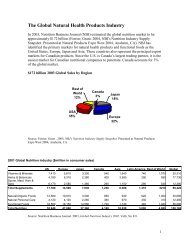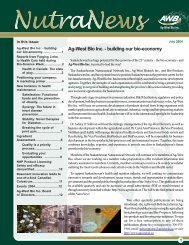Beyond Borders: Global biotechnology report 2010
Beyond Borders: Global biotechnology report 2010
Beyond Borders: Global biotechnology report 2010
Create successful ePaper yourself
Turn your PDF publications into a flip-book with our unique Google optimized e-Paper software.
together improved their net income by<br />
about US$1 billion, as well as up-andcoming<br />
firms such as Human Genome<br />
Sciences and Jazz Pharmaceuticals.<br />
Europe<br />
Like their US-based counterparts,<br />
European biotech companies<br />
demonstrated considerable resilience in<br />
the economic downturn. The number of<br />
public companies decreased by only 4%,<br />
from 179 companies in 2008 to 171 in<br />
2009 — a much smaller drop than most<br />
industry watchers had expected.<br />
Revenues of publicly traded European<br />
companies grew from €11.0 billion in 2008<br />
to €11.9 billion in 2009 — an 8% increase<br />
that was well below the 17% growth seen<br />
in 2008. While several of Europe’s leading<br />
companies — including Actelion, Crucell,<br />
Elan, QIAGEN and Meda — continued to<br />
post double-digit revenue growth rates,<br />
UK-based Shire saw a significant slowdown<br />
on its top line. This was largely the result<br />
of the introduction of generic competitors<br />
to Adderall XR, its blockbuster drug for<br />
treating attention deficit hyperactivity<br />
disorder. Excluding Shire, Europe’s other<br />
large companies — those with revenues<br />
greater than €200 million — saw their<br />
combined top line expand by a robust 14%.<br />
However, smaller public companies below<br />
the €200 million threshold saw revenues<br />
decline by 1%, dragging down the overall<br />
sector’s performance.<br />
As in the US, R&D expenditures failed to<br />
keep pace with revenue growth. European<br />
public companies’ R&D expenditures<br />
were essentially flat, posting a modest 2%<br />
decrease in 2009. This was driven not by<br />
a few large companies, but rather by R&D<br />
cutbacks across much of the industry.<br />
Similar to the situation in the US, close to<br />
60% of public companies reduced their R&D<br />
expenditures in 2009.<br />
US <strong>biotechnology</strong> at a glance, 2008–09 (US$b)<br />
Public company data<br />
Ernst & Young survival index, 2008–09<br />
2009 2008 % change<br />
Product sales 48.2 53.9 -11%<br />
Revenues 56.6 65.1 -13%<br />
R&D expense 17.2 22.6 -24%<br />
Net income (loss) 3.7 0.4 782%<br />
Market capitalization 270.4 340.7 -21%<br />
Number of employees 109,100 120,300 -9%<br />
Financings<br />
Capital raised by public companies 13.5 8.6 58%<br />
Number of IPOs 3 1 200%<br />
Capital raised by private companies 4.9 4.4 10%<br />
Number of companies<br />
Public companies 313 366 -14%<br />
Private companies 1,386 1,405 -1%<br />
Public and private companies 1,699 1,771 -4%<br />
Source: Ernst & Young<br />
Data were generally derived from year-end information (31 December). The 2009 data are estimates based on January—September<br />
quarterly filings and preliminary annual financial performance data for some companies. The 2008 estimates have been revised for<br />
compatability with 2009 data. Numbers may appear inconsistent because of rounding.<br />
US Europe Canada<br />
2009 2008 2009 2008 2009 2008<br />
More than 5 years of cash 30% 20% 45% 28% 22% 19%<br />
3–5 years of cash 8% 5% 11% 7% 5% 4%<br />
2–3 years of cash 8% 11% 7% 13% 5% 0%<br />
1–2 years of cash 18% 20% 12% 14% 17% 19%<br />
Less than 1 year of cash 36% 44% 25% 37% 51% 57%<br />
Source: Ernst & Young and company financial statement data<br />
Chart shows share of public companies in each location. Numbers may appear inconsistent because of rounding.<br />
The cost cutting helped boost the sector’s<br />
net income by a remarkable 68%, as<br />
combined net loss fell from €913 million<br />
in 2008 to only €288 million in 2009.<br />
Out of this €625 million improvement on<br />
the bottom line, €147 million came from<br />
the decrease in public company count,<br />
since most of the companies that ceased<br />
operations or were acquired during the<br />
year were in a net loss position. Despite<br />
slowing revenue growth, Shire was able<br />
to deliver strong growth on the bottom<br />
line, and a number of other companies<br />
— including Genmab, Meda, Photomed,<br />
Q-Med and QIAGEN — posted strong<br />
increases in net income.<br />
59








